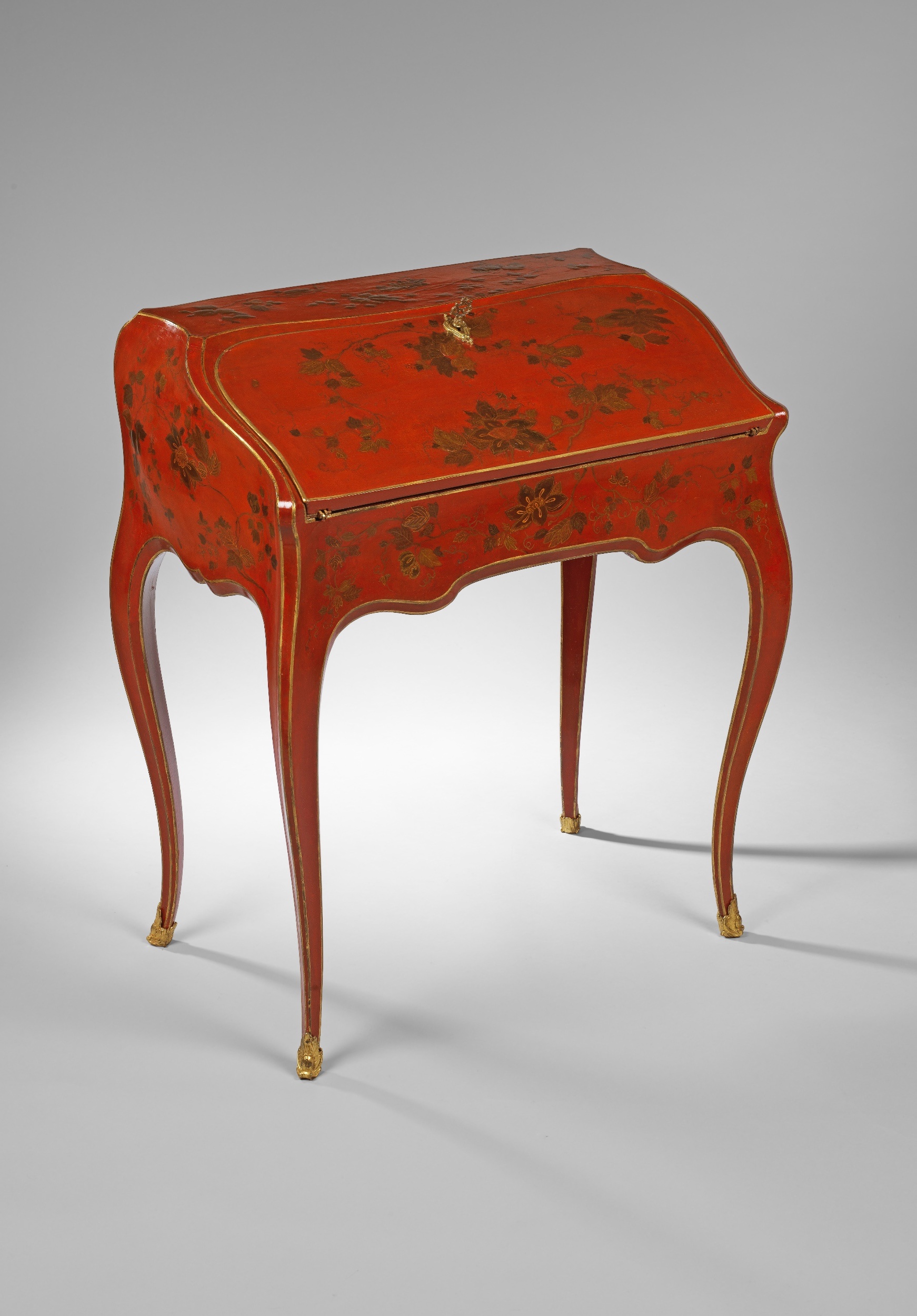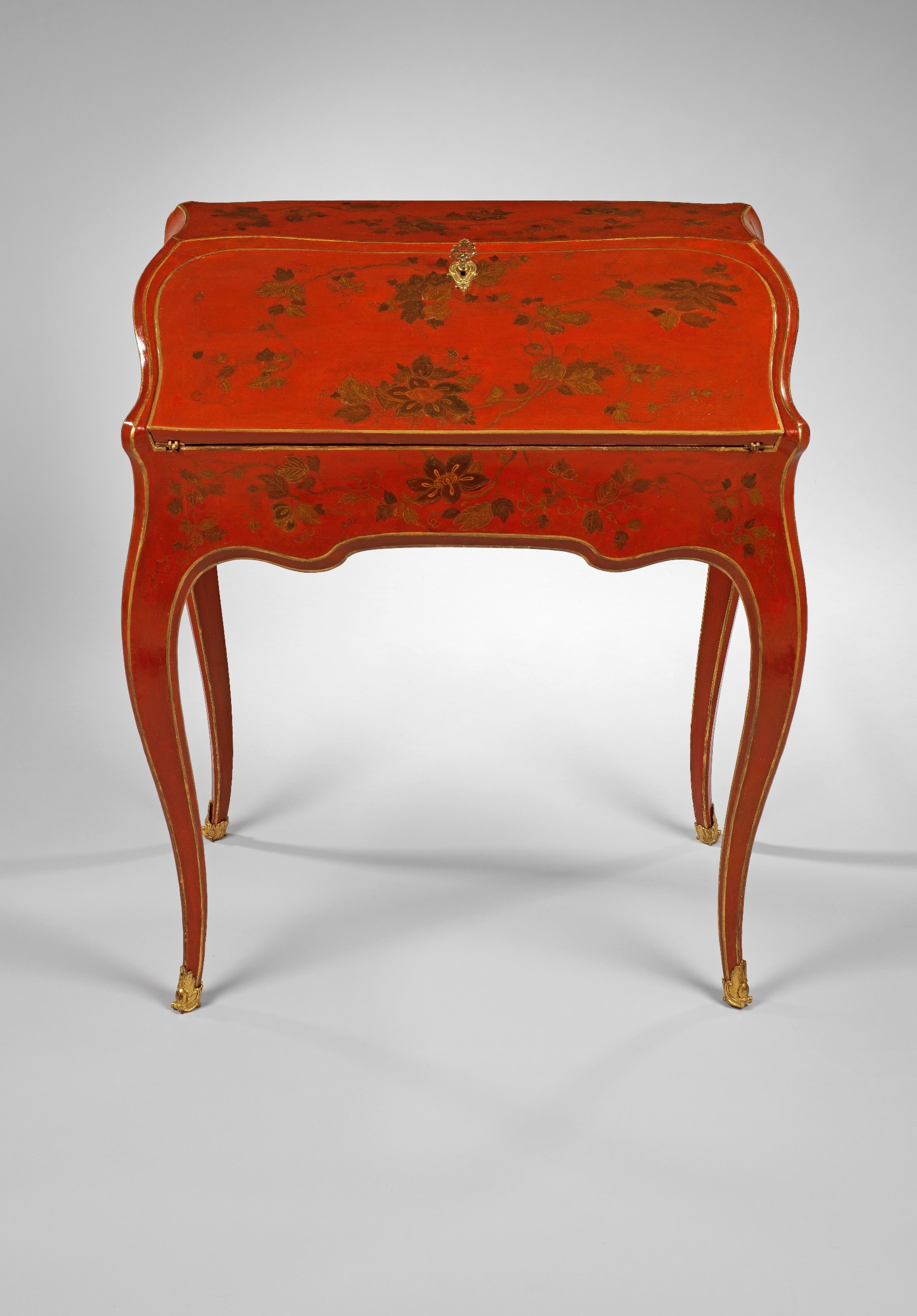



The scarlet lacquer bureau is decorated in gilt and subdued polychrome colours with flowers and foliage, with thin gilded bands following the contours of the piece. The fall front, which has a simple scroll escutcheon, opens to reveal a tooled green leather writing surface stamped with the coat of arms of the Duc de Choiseuil. The marquetry interior is inlaid with flowers and foliage on a diagonal ground and it contains an upper shelf with a central pigeonhole and two blue silk lined drawers below, one of which contains two silver ink pots made in Paris in 1739 by Antoine Jossey, with the charge mark of Louis Robin. The central well is divided into two compartments with two slides, one of which recedes and the other which slides across sideways. On cabriole legs with foliate foot mounts, stamped with the “C” Couronne 1745 -1749. With an inventory number 50 painted in black on the underside and stamped twice JME on the underside.
The Duc de Choiseuil
The Marquis de Blagny
Bernard Van Risanburgh ( 1696 – c.1765 ) was one of the most innovative ebenistes of the 18th Century and one of the first to use Japanese lacquer to embellish his furniture. The lacquer was supplied by the marchand-mercier for whom he worked, and who included Herbert, the first marchand to deliver lacquer furniture to the Garde-Meuble Royal, and later Duvaux and Poirier. The marchands could afford the extremely high price of imported lacquer screens and cabinets and were prepared to take the financial risk, involved whereas an ebeniste, even a successful one, would have been unlikely to be able to raise sufficient funds. The inventory taken on Van Risenburgh’s death listed twenty pieces of furniture, nearly all of which were unveneered and incomplete; tending to endorse the view that he would have been sent specific instructions and materials, such as lacquer and porcelain plaques, from the marchand-mercier.
The majority of Van Risenburgh’s surviving pieces decorated in lacquer are commodes, encoignures and large secretaires, although a blue lacquer bureau de dame or secretaire en pente stamped by him is illustrated by Alexander Pradère (1989, p.192, no. 178 ). On the same page, Pradère also illustrates a bureau de dame with floral bois de bout marquetry, in which flowers inlaid in kingwood stand out against a ground of lighter wood, of either bois satiné or, on his later pieces, tulipwood.
The form of the bureau de dame would appear to date from the 1740’s. The first mention of a bureau en pente is in the journal du Garde-Meuble of 1745 in reference to a piece delivered by Herbert to Versailles for the use of the Dauphine. It was designed for use in a lady’s boudoir rather than in formal rooms. It was small, light, portable and, being decorated on all sides, could be placed anywhere within a room.
Lacquer:
The European obsession with the East dates from the thirteenth century, when the extraordinary accounts of Marco Polo’s travels first revealed the existence of these distant and exotic lands.
Since the Middle Ages Europeans had traded with the Orient, importing silks, spices and precious perfumes, and collecting strange and appealing objects for their Kunstkammern or cabinets of curiosities. The importation of lacquer at the end of the sixteenth century exercised a particular fascination on the European mind that, along with imported porcelain, was to influence European art for centuries to come.
The extraordinary new material was keenly sought after in Europe and commanded consistently high prices. These factors led Europeans first to analyse its constituents and then to imitate it. The search to discover the secret of true lacquer in the seventeenth century had many parallels to that in the eighteenth for the means of making porcelain.
The first scientific investigations into the nature of lacquer were totally unsuccessful, even making the chemists physically ill. This was the case in around 1690 at the court of the Grand Duke of Tuscany, Cosimo III de Medici, although later the Jesuit Filippo Bonnani while working for the same court, met with more success. Bonnani was the first to report accurately on the properties of lacquer and he became convinced that it could not be made in the West. Indeed, as was later discovered, eastern lacquer consisted of the resin or sap of the Rhus Vernicifera tree, which could not be grown, in the West. Bonnani concluded that Europeans would have to satisfy themselves with substitutes, recommending varnish or shellac, both of which were already in use throughout Europe by lacquer masters known as “Japanners”.
The shellac as it was used by Europeans, actually came from India and differed from the Oriental resin. Shellac is a green substance deposited on the branches of trees by the insect Coccus Lacca which feeds on the sap. The resin is obtained either by scraping the branches or by taking the whole twig; once collected, it is slowly heated and then sieved to remove any waste. While it is still hot it is spread in thin layers and left to dry. It is then broken up into small flakes and stored ready for use. Although the resin serves as a passable imitation lacquer, it does not possess the brilliant, smooth and durable properties of the true variety.
A second reason for the use of imitation lacquers stemmed from a European disinclination to devote the same painstaking care to applying it as would have been given by a craftsman from the East. This was partly a matter of economics and of philosophy. The differing attitude is neatly summarized by Hans Huth in Lacquer of the West (Chicago, 1971): “one can fathom what this means if one imagines a master of Zen philosophy at work on a piece of lacquer and then thinks of a European craftsman obeying the whims of a Prince in fashioning a china cabinet à la mode.”
It seems the Europeans had little understanding of the laborious nature of the production of oriental lacquer. For example, the precious Japanese Guri lacquer – the most prized of all – required polishing forty or more times in a sealed room with the lacquer worker wearing as few clothes as possible so as to avoid creating dust that might settle on the lacquer as it dried. This practice took no account of the toxic nature of the resin itself. By contrast, the Western craftsman had an easy time of it. Nonetheless, the results achieved by European lacquer workers were remarkable in the degree to which they approached the quality of eastern pieces.
This B.V.R.B. bureau de dame displays all the richness of the mid-eighteenth century. Standing on long elegant cabriole legs with its graceful curves, it is very much in the French rococo style. It would have been integrated with similar pieces within the room, and often the furniture would have been specifically designed and placed by the architect in charge of the overall planning of the rooms. These small bureau would be installed in the private apartments of a lady, the furniture being very light in comparison to that made of more public rooms. The gilt bronze mounts subtly articulate the piece, giving ornamental accent only to the shoulders bronze mounts subtly articulate the piece, giving ornamental accent only to the shoulders and feet, in contrast to the more disciplined quality of the secretaire à abatttant with its large array of gilt bronze work.
The bureau de dame reveals much of the Western view of the East as an enchanted fairyland, to be freely interpreted with no attempt at realism. The quest for the exotic is abundantly evident, and while the techniques were impossible to assimilate fully in their original form, the largely anonymous lacquer masters of eighteenth-century France deserve all credit for their invention of an entirely novel and exciting decorative skill.
| Dimensions | CM | Inches |
|---|---|---|
| Width: | 67 | 26.5 |
| Depth: | 42 | 16.5 |
| Height: | 80 | 38 |